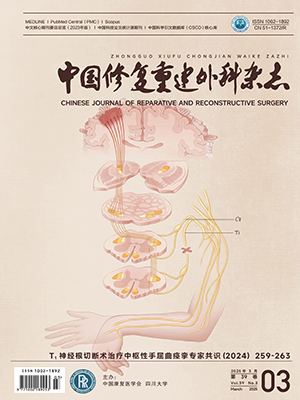Citation: HUPeng, TANGXiujun, WEIZairong, WANGDali, SUNGuangfeng, WANGBaoyun, ZANQin. CLINICAL APPLICATION OF REPAIRING WOUND IN WRIST WITH FLAP SUPPORTED BY PERFORATING BRANCH OF FOREARM RADIAL ARTERY AND CATENA-FORM BLOOD VESSEL. Chinese Journal of Reparative and Reconstructive Surgery, 2014, 28(4): 491-494. doi: 10.7507/1002-1892.20140110 Copy
Copyright © the editorial department of Chinese Journal of Reparative and Reconstructive Surgery of West China Medical Publisher. All rights reserved
-
Previous Article
ESTABLISHMENT OF A MODEL OF ISCHEMIC INTERVERTEBRAL DISC DEGENERATION IN RHESUS MACAQUES WEIFuxin, WANGLe, ZHOUZhiyu, CUIShangbin, LIUShaoyu, ZOUXuenong, ZHONGRui, LIANGZijian -
Next Article
CLINICAL APPLICATION OF FOREARM INTEROSSEOUS DORSAL ARTERY PERFORATOR SUBLOBE FLAPS TO REPAIR TWO WOUNDS IN DORSAL HAND OR WRIST WANGBaoyun, TANGXiujun, WEIZairong, WANGDali, SUNGuangfeng, WANGBo, QIJianping, JINWenhu




